We've just now done a 10-day journey from Mackinac Island, a peaceful isle of horses and bicycles surrounded by Lake Huron, to Stratford Ontario, perhaps not the Olympus of theater in Canada but a mighty mount nonetheless, surrounded by seemingly endless miles of farmland. In our next entry we'll say a bit about Stratford and the Shakespeare (actually Shakespeare Plus these days) Festival. This is about getting here.
As promised last time, we've now got a map of our route from Milwaukee WI to Ithaca NY. And
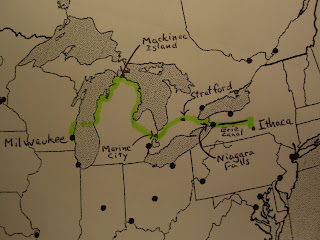
as you can see from the map, we spent the entire time to Mackinac Island following the shore of Lake Michigan. In planning the trip, we wondered why there were many, many more B&Bs, inns and motels along the shore of Lake Michigan than along the shore of Lake Huron, which this leg has mostly taken. The answer is simple -- it's fairly boring on this side of the lower peninsula.
Lake Huron is in many ways like Lake Michigan -- identical elevation above sea level, same temperature, even a tad bigger -- but location is everthing,
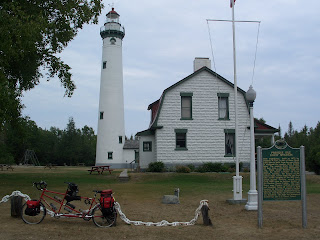
as they say. The Lake Huron shore of Michigan's lower peninsula is on the leeward side of lake weather, and thus lacks the sand dunes and hills that make the western shore dramatic. It also is largely a straight or gently curving shore, unlike the Lake Michigan side with numerous bays and peninsulas that make for interesting boating and that provide picturesque sites for summer homes. This lighthouse at Presque Isle was one of the few scenic spots, and it gives us a chance to show you all what our fully-loaded bike looks like with the new Ortlieb panniers that were a retirement present to Jeff from his office.
It also has far fewer towns. Leaving the ferry from Mackinac Island to Mackinaw City, we went 60 miles our first day, passing through only one town. Only occasionally did the road get close enough to Lake Huron to see the lake. The up side was that the road was incredibly flat and blessed with a wide shoulder and little traffic. Rogers City, that first destination, has the world's largest open-pit limestone quarry. Not exactly a big tourist draw, but there was an overlook on our route so we stopped to take this photo. That's an enormous truck in the upper right hand
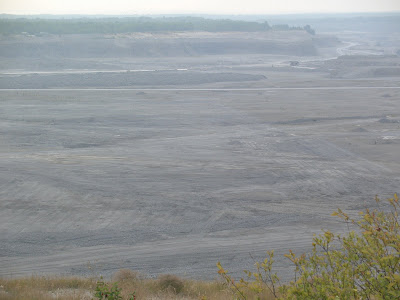
corner of the photo, a few miles from our vantage point. The most interesting thing about the quarry is where the limestone goes. The quarry is owned by U.S. Steel because they use most of its output in making steel. No, steel is not made from limestone, but a few hundred pounds of it are added to every ton of molten steel to remove impurities from the iron ore. A brochure we found in Rogers City informed us of many other things this limestone goes into, from fertilizer to the toothpaste you may have used today.
A few days later, we were in a community a bit above the "thumb" of Michigan when we saw an item in a local paper describing the demographics of the county we were in. The median household income, the article said, was about $25,000. This stunned us. That's not much above the poverty level, we thought, and another newspaper article a few days later confirmed this (poverty level for a family of 4 is now defined as $20,400, and the median household income for the nation is over $48,000). But the roads here were in excellent condition, something we bicyclists pay an inordinate amount of attention to, well paved and well-swept. The houses were not large or fancy in this area, but not ramshackle either. The next day, while still in that county, we decided to skip the cafes and have our first picnic lunch, using the compact butane stove and titanium pot we'd been carrying for the first time. We went to a quite large supermarket and started
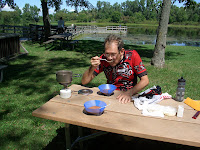
looking for something healthy to cook. We thought we'd cut up a sausage and add it to soup, but there was nothing that was less than 80% fat -- literally! We looked for ground beef, and the leanest to be found was 19% fat, not the 7% that every grocery in Seattle routinely carries. We asked a grocery employee, and she said that low-fat doesn't sell there, cheap sells there. Their customers, she said, don't care what's in the food as long as it's inexpensive. We ended up buying cooked chicken in the deli section and a can of soup so we could say we used the stove, but the main thing we got out of lunch was an interesting lesson in how economics shape entire communities.
Bay City is at the inside of the thumb, and a blog we read last year from some Canadian bicyclists who circumnavigated Lake Huron described coming into Bay City as something of a nightmare of truck traffic, strip malls and disappearing road shoulders. Jeff studied the maps extra hard, and thought he had a good alternative, and it was one of those special days that you remember for a long time. Granted, a rare tail wind helped, but the road he had selected was flat and nearly traffic-free, through pleasant farm country until we got close to Bay City. From that point, there appeared on the map to be a way along the shore of Lake Huron, but the resolution of the map wasn't good enough to see if the road was continuous or a series of dead-end roads. As it turned out, there were two dead-ends, but in each case friendly neighbors told us how to find footpaths around a garage of a certain color or shape, where we could jump to the next road and continue on. The second "secret passage" brought us into a wildlife preserve and onto a beautiful rail trail that brought us right into Bay City.
Bay City is an unlikely place to go sightseeing, but they've done a remarkable job of beautifying the
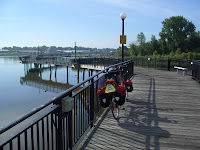
shore of the Saginaw River, and the next day

we had a delightful ride along a biking/walking path that follows and at one point seen in the photo takes you right over the river on a wooden testle. Along the way was the site of a long-gone shipyard that chose to close rather than switch from building wooden ships to metal. Some of the wood vessels they had built rested at their docks after the boats had joined the shipyard in retirement, then fire swept through and burned the shipyard to the ground and the boats to the water line. To this day the ghostly remainder of the boats' skeletons can be seen. A nearby sign gave the name and date for each skeleton, from the 1880's to about 1905 for the most recent of the ghosts.
We had wondered what Frankenmuth would be like. It is widely known as a quaint town with German roots, and from the web seemed to be a place a lot of tourists went to. With the help of another cyclist from Bay City, we found an idyllic route down roads where we saw no cars in either direction for 20 or 30 minutes at a time, and checked it out. It was fairly underwhelming. It's authentically German, all right, named by German missionaries from Franconia ("Frankenmuth" means "courage of the Franconians") who intended to turn the local Chippewa into good Lutherans. The tourist guides are discretely quiet about the level of success they did or didn't have. In the early 1900's a restaurant founded in the 1880's began to get a name for itself by serving all-you-can-eat chicken dinners, and folks from nearby cities like Flint (20 miles away) and even Detroit (85 miles out) who were getting more prosperous building these new-fangled devices for Henry Ford would drive to Frankenmuth and enjoy a good meal. In the 1950's the restaurant decided to play up the German theme and added some Bavarian (not Franconian, interestingly enough) decor, and a few other places followed suite. Now the tourist buses bring in hordes, and the main focus of the trip appears to be lunch and/or dinner in town. Frankly (pardon the pun), there's not much else to see except for the usual assortment of kitschy gift shops and sweet shops, in this case with various German or ersatz-German themes. Ironically, there was only one restaurant that served sauerbraten, which Jeff insisted on since he knew this was his only chance to find this on a menu on this trip. Louise was very pleased with her German smoked pork, and both agreed that the sauerkraut and blaukraut (sweet and sour red cabbage, also known as rotkohl) were outstanding.
Two days of riding still more quiet roads through the Michigan farmland brought us a hundred

and five miles to the St. Clair River, which drains Lake Huron into Lake St. Clair, sometimes called the "sixth Great Lake," which then drains to Lake Erie. On our side, Michigan; on the other, Ontario Canada. The St. Clair looked like a lake, calm water just rustled on top by wind and chop, until you stopped to watch the ferry go back and forth from Marine City MI to Sombra ON, pointed 30 or 40 degrees upstream in order to proceed straight across against the current carrying the waters of three Great Lakes on their way to the remaining two. Great ships passed by silently all day and all night, perhaps some to or from the limestone quarry in Rogers City, or the great iron ore fields above Duluth, or the grain elevators of Chicago.
Our destination was the Heather House B&B in Marine City, and it was one of our best stopovers. As the photo shows, it is a gorgeous Victorian home,

with a large front porch and a separate second-story porch for each of the five guest rooms. There was a round library/sitting room in that turret, a half-story above the second floor, where we unwound from the riding and checked out some of their books. Louise liked the first two chapters of Nicholas Evans' "The Loop" that she read there so much that she wrote down the title and, amazingly enough, found it in a second-hand bookshop that same evening on the way to dinner.
But good B&Bs are more than just beautiful houses. Our host was Barb, who is running the place now that her parents have retired from founding and operating it for 18 years. Sometimes it's the hosts,

sometimes the other guests, sometimes both that make for a great experience. Barb more than made up for the absence of other guests with her warm welcome, her much-appreciated offer to use the washer/dryer, and a great breakfast the next day. The main course was a wonderful quiche lorraine, but we took this shot before it arrived to show off the beautiful period silverware, china and linens she put out for us. She's finishing up coursework to become an elementary school teacher and the B&B is on the market. We certainly hope she finds special people to continue on with this special place.
Alas, that breakfast, the ferry boat crossing and the pleasant welcome by Canadian Customs were the last good moments of that day. We had spent the evening before
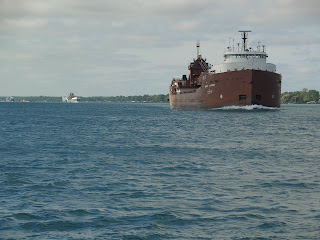
watching not only the boats in the St. Clair but also a terrific light and sound display as thunderstorms moved through Marine City just after we returned from dinner. While they brought the temperature down from the mid-80's to the low-70's, they also brought a north wind, at the very moment when our southward-trending route turned to a zig-zag course alternating between straight north and straight east. And no light breeze was this -- it was a steady 15 to 20 mph blow, with occasional higher gusts, and we struggled. Not only when going north, as you can well imagine, but also going east, as Jeff would have to clench the handlebars to keep the bike straight against the cross wind. The physical and mental strain was the greatest we'd had to this point.
Adding to the misery was the fact that Ontario saves money on its roads by not bothering with paved shoulders. As long as no one was coming the other way, vehicles passing us were very good about giving us a wide berth, cars and trucks both. And cars coming up behind us were very nice about slowing to let oncoming traffic clear before passing. These were not overly busy roads. But every now and then we could see a truck coming up behind us, cars or trucks approaching, do the math, and see that everyone was going to be right where we were in 15 or 20 seconds. As carefully as we could, we'd hit the brakes down to 8 mph or so and coast off into the soft shoulder, hoping we'd stay upright while coming to a complete stop out of the way. We always did, but it was not a pleasant exercise, and it was one we went through well over a dozen times that day.
Somehow or other, we convinced ourselves to bike 40 miles like this, until we reached a point on the route where any vehicle going by was very likely going to go the remaining 15 miles to our destination down that same road. It wasn't just the wind, the truck traffic on this road was distinctly heavier and we really did want to live to bike another day. We pulled over and watched for pickup trucks, sticking out our thumbs every time one approached. Two stopped but had their flatbeds filled, which we couldn't see as they approached. We thanked them profusely and said we'd wait, sooner or later we'd get help. And, sure enough, we did, in the form of Murray.
Murray was headed to a point just past the motel where we had a reservation, and said he could take us the whole way if we didn't mind stopping for 15 minutes at his house en route. No problem at all! He drove a few miles and pulled off the road and back a few hundred yards to what appeared to be a beautifully maintained 19th century brick Italianate Gothic home, where Murray introduced us to his wife Denise. Denise gave us a tour of their home, which is in fact only 10 years old, but done entirely in late 19th century style, down to the intricate oak woodwork, 19th-century floral wallpaper designs in several rooms, Victorian furniture, and interesting ceilings, some textured in wet plaster with intricate swirling designs, the kitchen ceiling wallpapered with a textured white paper that looked exactly like an old pressed-tin covering.
Our ride and visit with Murray and Denise helped calm both mind and body, but we both had a restless sleep, filled with tension from the day before. The next day we had ten more miles to go on that busy road before we could get onto quieter country roads. The cafe attached to the motel did not open until 8. We decided we could not wait until then, as the traffic and the wind (predicted to be out of the north though a little softer at 10-12 mph) would have picked up too much. We got up before the sun did, had a Zone Bar and a few
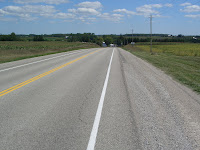
almonds for "breakfast," and were on the road just after sunrise at 7 am. By the time we'd done the 10 miles with only 3 trucks having gone by, none requiring us to go off the road and stop, we knew we could survive the day. Our spirits brightened, our muscles relaxed, and we pedalled on. It was our longest day at 66 miles, and there was another stretch of 10 miles on a semi-busy shoulderless road with occasional trucks, but the wind was not as troublesome, there were occasional narrow shoulders, and we knew that there was an end to this little period in purgatory, with Stratford as the payoff at the end of the day.
Well, we're now in pleasant Stratford, but our stay here and the three plays we stopped to see here at the Festival will have to await our next blog. May the wind be at your back, as the weatherman says it will be for us the day we leave.
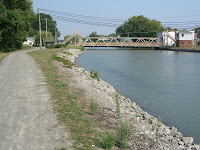 and past various historic buildings and
and past various historic buildings and 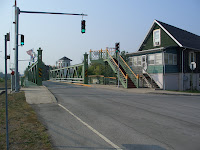 canal structures, such as the lift bridges that have stairways so that pedestrians can still cross the canal when the bridge is in the "up" position, or the viaduct that carries the canal past the town of Gasport, part of which is in the photo.
canal structures, such as the lift bridges that have stairways so that pedestrians can still cross the canal when the bridge is in the "up" position, or the viaduct that carries the canal past the town of Gasport, part of which is in the photo. 
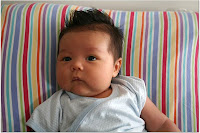 days to pass -- our grandaughter Elise was still in the throes of a bad virus, and not a very happy camper. But little Issei, our 6-week-old grandson, has been all we could want in a grandchild, and we're getting quite used to him and he to us in the three days since we arrived. We're looking forward to spending lots of time with the grandchildren and their mom and dad, Lisa and Ray, in the coming 4 months.
days to pass -- our grandaughter Elise was still in the throes of a bad virus, and not a very happy camper. But little Issei, our 6-week-old grandson, has been all we could want in a grandchild, and we're getting quite used to him and he to us in the three days since we arrived. We're looking forward to spending lots of time with the grandchildren and their mom and dad, Lisa and Ray, in the coming 4 months. days to pass -- our grandaughter Elise was still in the throes of a bad virus, and not a very happy camper. But little Issei, our 6-week-old grandson, has been all we could want in a grandchild, and we're getting quite used to him and he to us in the three days since we arrived. We're looking forward to spending lots of time with the grandchildren and their mom and dad, Lisa and Ray, in the coming 4 months.
days to pass -- our grandaughter Elise was still in the throes of a bad virus, and not a very happy camper. But little Issei, our 6-week-old grandson, has been all we could want in a grandchild, and we're getting quite used to him and he to us in the three days since we arrived. We're looking forward to spending lots of time with the grandchildren and their mom and dad, Lisa and Ray, in the coming 4 months.
